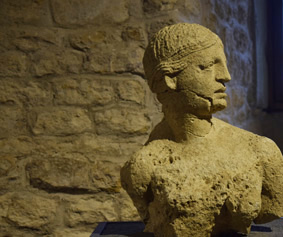

 |
April 21st AVENTICUM - AVENCHES アヴァンシュ市
|
 |
Our private guide Mr. Schertz was waiting for us. シェルッツ氏が私達を出迎えてくれました |
||

Mile stone |
フレスコ画 紀元2世紀 |
The medieval town and the Roman amphitheater
16世紀の街とローマの劇場は仲良く残されている
The amphitheatre was built in 130 AD. Ms. Yasco Nagashima |
 |
Ms. Fumiko Hoshino at the entrance |
AVENTICUM At the end of the 1st century B.C., Avenches had become a Roman settlement. Under the reign of August during the 1st century A.D. , it was the largest city and the capital of Romanized Swiss tribes. Its name comes from the spring goddess Aventia. Under Roman patronage Aventicum developed into a blooming commercial center with over 20,000 inhabitants. Its amphitheater is well preserved and the Roman museum presents a good collection of daily life items as well as a bust of Emperor Marcus Aurelius in pure gold (one of three found in Europe). Other sites include the public baths, a theater, a temple and parts of the city walls. Avenches belongs to the list of most important archeological sites of Switzerland. The members of MG School were given special permission to take stone rubbings of inscriptions. 紀元前15年頃、Avenches (ラテン名Aventicum)はローマの集落になりました。紀元1世紀、皇帝アウグストゥスの支配下、ヘルヴェティアの首都でした。名前は、春の女神Aventiaから来ています。ローマの庇護を受けていたヘルウェティイ族の商業の中心地へと発展したここの町の人口はおよそ20,000人でした。 円形劇場の保存状態は非常に良く、その他、浴場、神殿、劇場と町の廻りには城壁の跡が残っています。ローマの博物館の中に発掘された作品の中に皇帝のマルクス・アウレリウスの黄金の胸像があります(在位:161年 – 180年)。スイスでは、Avenchesが最も重要な遺跡の一つです。 MGスクールは特別な許可を得て、拓本を採る事が出来ました。
|
|
 Altar dedication to the Gods of Aventicum from its people - 2nd c. AD |
皆で協力して、星野史子さんも一生懸命です。 |
長嶋泰子さんの拓本 マルクス・アルピイウス・ヴィリリスの墓石1-2世紀 |
ガイドのSchertz氏とMGの田中会長も興味深く見てくれました。
|
|
The bust of the 16th Roman Emperor, Marcus Aurelius Antonius マルクス・アウレリウス、第16代ローマ皇帝(在位:161年 - 180年) |
The golden bust of Emperor Marcus Aurelius was discovered マルクス・アウレリウスの黄金の像は水道配管の中で隠れていました。 |
Clay pots and leather sandal on stone 土器と革製サンダル |
Pottery and glassware 土器とガラスの器 |
Kitchen ローマ時代の厨房を再現 |
Glassware ガラスの器
|
House with floor heating system |
Room with frescoe フレスコ画の間
|
|
Medical and cosmetic tools
|
Oil lamps 陶器のオイルランプ
|
Writing instruments: stylus, seal, wax tablet, ink pot, lamps etc. |
Sabazius hand for mother and child with several gods:
|
Silenus, tutor to the wine god Dionysus
|
Cigonier sanctuary |
Gates of the theather |
Thank you to our guide for an enriching experience |
|